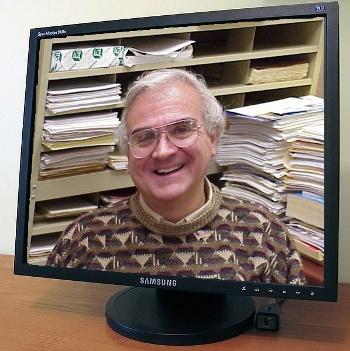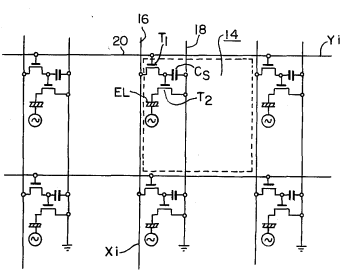Thomas P. Brody, Co-Inventor of the Active Matrix LCD
September 27, 2011
The majority of larger
display screens are
active-matrix liquid crystal displays (AMLCDs). This was true also for smaller displays, as on
cellular telephones, until recently when
organic light emitting diode (OLED) and
electronic paper displays have become popular. AMLCDs were invented by Thomas P. Brody in the early 1970s while he was at the
Westinghouse Research and Development Center, near
Pittsburgh. Thomas P. Brody died on September 18, 2011, at age 91.[1]
Until about ten years ago,
cathode ray tubes were used almost exclusively as
television and
desktop computer displays, since they combined the useful properties of high definition, excellent
color rendition, high
contrast ratio, and low cost.
Over the span of the last twenty-five years, my family owned as many as twelve cathode ray tube displays that progressed in screen size from twelve
inch to a behemoth twenty-one inch that took two men to carry. I can hold the nineteen inch LCD displays we now use two at a time, one in each hand. That's progress that you can feel!

An active-matrix liquid crystal computer display.
(LCD photo by Briho, via Wikimedia Commons))
Liquid crystals have the useful property that their
optical rotation can be modulated by an
electric field. A thin film of liquid crystal sandwiched between
transparent electrodes and
polarizing filters forms a light modulator that can be used as a display
pixel. Color filters added to the sandwich allow color display.
The simplest form of
LCD display is a
passive matrix in which the pixels are defined by a crosshatch of row and column electrodes. Application of a
voltage to an appropriate row and column address will activate a pixel. The problem with the passive matrix approach is the one thing that plagues all high speed circuitry; namely,
parasitic capacitance. Long row and column electrodes have large capacitance that limits display refresh rate.
Starting in 1968, Brody was doing research at Westinghouse on
thin film transistors made from
cadmium telluride. The immediate applications were for flexible versions of conventional circuitry, but the Westinghouse team made the first active-matrix LCD in 1972, followed by an active-matrix
electroluminescent display in 1973.[2] In 1974, they demonstrated real-time
video using the active-matrix approach. The basic AMLCD circuitry, as shown in a figure from the active-matrix patent, is essentially unchanged today.[3]

Figure three from US Patent No. 4,042,854 by Fang-Chen Luo and Thomas P. Brody, "Flat panel display device with integral thin film transistor control system," August 16, 1977.
(Via Google Patents).[3])
In a decision understandable only to
MBAs who are skilled at the
divination of entrails in their arcane temples, Westinghouse canceled the active-matrix program in 1979. It was not as if the research program had been running smoothly until then. Research groups at Westinghouse and other large corporations were required to beg for money from operating units that were overly concerned with near-term profits. Scientists needed to paint an optimistic picture of the immediate profit potential of their research to get funding; and when the inevitable road blocks appeared in the research road map, research funding was cut.[4]
Brody was committed to his technology, so he quit Westinghouse to form Panelvision Corporation to manufacture AMLCD displays.[4] Panelvision marketed its first AMLCD display in 1983. In 1985, it was acquired by
Litton Systems, and Brody went on to form Magnascreen Corporation, which, as its name implies, produced large-area displays. Brody left Magnascreen almost immediately, but he remained active in AMLCDs via his consulting group, Active Matrix Associates.[1] Brody ended his career as chief scientist for
Advantech US, a manufacturer of low cost active-matrix backplanes for various display technologies, and he was active there until his death.[1]
According to the
Pittsburgh Post-Gazette, Brody was born in
Budapest, Hungary, where he qualified to enter the
1936 Olympics in the
100-meter freestyle, but never competed. In 1938, he went to
London to train as a
printer in order to take over the family business. He remained in England and served in the British Army during
World War II. After the war, Brody received his
Ph.D. in
theoretical physics at the
University of London in 1953, and he taught
physics there through 1959, when he received a job offer from Westinghouse.[1]
Brody received two major awards from the
Society for Information Display. These were a 1976
Special Recognition Award, and the first
Karl Ferdinand Braun Prize in 1987.
References:
- Obituary: Thomas P. Brody, Pittsburgh Post-Gazette, September 24, 2011.
- T.P. Brody, Fang Chen Luo, Z.P. Szepesi and D.H. Davies, "A 6 × 6-in 20-lpi electroluminescent display panel," IEEE Transactions on Electron Devices. vol. 22, no. 9 (September, 1975), pp. 739-748.
- Fang-Chen Luo and Thomas P. Brody, "Flat Panel Display Device With Integral Thin Film Transistor Control System," US Patent No. 4,042,854, August 16, 1977.
- Richard Florida and David Browdy, "The invention that got away," Technology Review, vol. 94, no. 6, (August, 1991), pp. 42-55.
Permanent Link to this article
Linked Keywords: Display; active-matrix liquid crystal display; cellular telephones; organic light emitting diode; electronic paper; Westinghouse; Research and Development Center; Pittsburgh; cathode ray tube; television; desktop computer; color rendition; contrast ratio; twelve inch; Wikimedia Commons; Liquid crystal; optical rotation; electric field; transparent electrode; polarizing filter; pixel; LCD display; passive matrix; voltage; parasitic capacitance; thin film transistor; cadmium telluride; electroluminescent display; video; Google Patents; Master of Business Administration; MBA; divination of entrails; Litton Systems; Advantech US; Pittsburgh Post-Gazette; Budapest, Hungary; 1936 Olympics; 100-meter freestyle; London; printer; World War II; Doctor of Philosophy; Ph.D.; theoretical physics; University of London; physics; Society for Information Display; Special Recognition Award; Karl Ferdinand Braun Prize.